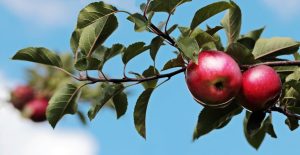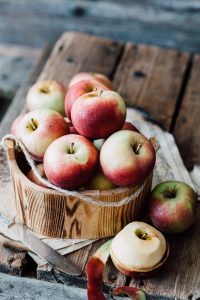Authored by John Schellinger, Certified Master Gardener
 There are literally thousands of cultivars of orchard apples, most of which are of one species, Malus domestica. One would think it would therefore be easy to tell when they are ripe, unfortunately this is not the case. In Wisconsin apples ripen from August to October. If you are trying to push the envelope and are growing long season varieties like Granny Smith and Braeburn these will ripen the first or second week of November. So how do you decide when to pick? Nursery catalogs will usually list average ripening dates. When looking at this make sure the nursery is in our same growing zone, Zone 5a. If not, you will need to adjust.
There are literally thousands of cultivars of orchard apples, most of which are of one species, Malus domestica. One would think it would therefore be easy to tell when they are ripe, unfortunately this is not the case. In Wisconsin apples ripen from August to October. If you are trying to push the envelope and are growing long season varieties like Granny Smith and Braeburn these will ripen the first or second week of November. So how do you decide when to pick? Nursery catalogs will usually list average ripening dates. When looking at this make sure the nursery is in our same growing zone, Zone 5a. If not, you will need to adjust.
A complicating factor is the difference between maturity and ripeness. Mature fruit has reached its full size. Mature fruit will still have 30 to 40 percent starch and will continue ripening off the tree. Ripe fruit is at its sweetest having converted all the starch reserves to sugars. Mature fruit is best for long term storage while ripe fruit should be used in a few weeks. Consider how you want to use your apples when you decide to pick.
Some cultivars mature/ripen uniformly and can be picked all at once if used for the same purpose. Others such as Gala and Honeycrisp will spread their maturation over several weeks requiring multiple pickings. Early ripening cultivars also exhibit this trait and have a narrow window between stages.
Commercial orchards use an iodine test to determine starch content, pressure testing for fruit firmness and a refractometer to determine sugar levels. These tests are not inexpensive and generally not available for home use, so other means are necessary to determine when to harvest.
 The best a hobby orchardist can do is to be observant and start sampling a week or two before average ripening dates. Varieties with a blushed or striped color pattern will show a yellowing of the green background field as they approach ripening. Check the recess around the stem for the same color shift. Mature fruit of varieties ripening in late September and October will have a uniform brown seed color. Unfortunately, early cultivars like Lodi, Yellow Transparent, and Viking are overripe before the seeds turn color. Mature fruit will give slightly to thumb pressure but, this also damages the fruit so use immediately. The bruised area will give off excessive ethylene gas which accelerates ripening of any fruit stored with damaged apples. Develop your palate by tasting frequently. Once you get to know what each variety should taste like you will be able to detect the off-taste of too much starch.
The best a hobby orchardist can do is to be observant and start sampling a week or two before average ripening dates. Varieties with a blushed or striped color pattern will show a yellowing of the green background field as they approach ripening. Check the recess around the stem for the same color shift. Mature fruit of varieties ripening in late September and October will have a uniform brown seed color. Unfortunately, early cultivars like Lodi, Yellow Transparent, and Viking are overripe before the seeds turn color. Mature fruit will give slightly to thumb pressure but, this also damages the fruit so use immediately. The bruised area will give off excessive ethylene gas which accelerates ripening of any fruit stored with damaged apples. Develop your palate by tasting frequently. Once you get to know what each variety should taste like you will be able to detect the off-taste of too much starch.
Keep only unblemished fruit from the first pickings for long-term storage. Store at temperatures of 34 to 40 degrees Fahrenheit and high humidity. Plastic bags with vent holes work well.
Enjoy ripe fruit right away or process into cider, sauce, pie filling, and apple butter or dehydrate for quick snacks.
John Schellinger
Certified Master Gardener




